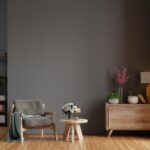Creating a serene and clutter-free home environment is the essence of minimalist home decor. In this article, we will delve into the core principles of minimalism and its benefits. By adopting a minimalist style, you can transform your living space into a haven of simplicity and tranquility.
Minimalist home decor centers around the idea of decluttering and simplifying your surroundings. By removing unnecessary items from your home, you can create a sense of calm and spaciousness. This practice not only enhances the visual appeal of your living space but also promotes mental clarity and relaxation.
The allure of minimalist decor lies in its ability to create an atmosphere that is both aesthetically pleasing and functional. With clean lines, neutral colors, and careful selection of furniture and accessories, you can achieve a timeless and elegant look in your home. Embracing minimalism allows you to focus on what truly matters, eliminating distractions and creating a sanctuary where you can unwind and recharge.
In the following sections, we will guide you through the process of implementing minimalist home decor. We will explore decluttering techniques, discuss color palettes that resonate with minimalism, provide insights on selecting furniture, offer tips on arranging accessories, emphasize the role lighting plays in creating a serene atmosphere, highlight room-specific examples for achieving minimalism in different spaces, and even discuss eco-friendly practices within this lifestyle.
With our comprehensive guide to minimalist home decor, you’ll have all the tools needed to embark on your own transformative journey towards simplicity and peacefulness within your home environment. Let’s begin.
Decluttering 101
One of the fundamental principles of minimalist home decor is decluttering. By removing excess belongings and simplifying our living spaces, we can create a sense of calm and tranquility. Decluttering not only benefits the aesthetic appeal of our homes but also has a positive impact on our mental well-being. This section will guide you through the process of effective decluttering, provide practical tips and techniques for each room, and address common challenges that may arise.
The Importance of Decluttering
Before diving into the decluttering process, it’s essential to understand why it is so crucial in minimalist home decor. Clutter not only creates visual chaos but also leads to a feeling of overwhelm and stress. By simplifying our surroundings and getting rid of unnecessary items, we free up physical space as well as mental space. This allows us to focus on what truly matters and promotes a sense of clarity and peace within our homes.
Practical Tips for Effective Decluttering
To effectively declutter your living space, it’s helpful to tackle one room at a time. Start with smaller spaces like closets or bathrooms before moving on to larger areas like the living room or bedroom. As you go through each room, ask yourself if an item serves a purpose or brings you joy. If the answer is no, consider letting go of it.
Additionally, consider implementing organization systems such as storage containers, shelving units, or baskets to keep your belongings neat and tidy. This will help prevent clutter from accumulating in the future.
Addressing Common Challenges
It’s not uncommon to feel sentimental towards possessions or encounter challenges while decluttering. We often attach memories or emotional value to certain items, making it harder to let go. In these situations, remind yourself that minimalism is about creating space for what truly matters. Consider taking photos of sentimental items before parting with them to hold onto the memories without the physical clutter.
Another challenge may be dealing with items inherited from family members or gifts you feel obligated to keep. In these instances, consider if the items align with your minimalist goals and values. If not, express gratitude for the sentiment behind them and find alternative ways to honor their memory or repurpose these objects.
Decluttering is an ongoing process, so allow yourself grace and patience throughout the journey. By simplifying and letting go of excess possessions, you’ll be well on your way to achieving a minimalist home decor that promotes peace, tranquility, and a clutter-free environment.
Selecting the Perfect Color Palette
When it comes to minimalist home decor, one of the key elements to consider is selecting the perfect color palette. The principle of “less is more” applies here, as a neutral color scheme is often favored to create a clean and serene atmosphere. By carefully choosing colors for your space, you can enhance the overall minimalist aesthetic and promote a sense of calmness in your home.
Neutral colors such as white, beige, gray, and muted earth tones are commonly used in minimalist design. These colors provide a simple backdrop that allows other design elements to stand out while creating a sense of openness and tranquility. When choosing a color palette, it’s essential to consider the psychology of colors and their impact on mood and perception. For example, white promotes cleanliness and purity, while soft blues or greens evoke a sense of serenity.
While a neutral color palette forms the foundation of minimalist decor, adding accent colors can help add depth and visual interest to your space. Consider incorporating pops of color through art pieces, cushions, or small decor items. However, it’s important to keep in mind that moderation is key – too many bright or bold colors can disrupt the minimalistic harmony. Additionally, incorporating diverse textures such as natural fibers or sleek metallics can further elevate the look of your space.
The concept of lessening visual clutter extends beyond physical objects to encompass empty spaces as well. Embracing negative space is pivotal in minimalist design to enhance the feeling of openness and simplicity. Avoid overcrowding surfaces with too many decorative objects or excessive furniture arrangements. Instead, focus on intentional placement of mindful accessories that serve both functional and aesthetic purposes.
Overall, selecting the perfect color palette plays a crucial role in achieving an inviting and calming environment through minimalist home decor. By opting for neutral hues as a base while thoughtfully incorporating accent colors and textures, you can create a visually appealing space that exudes tranquility without sacrificing personal style or comfort.
Streamlined Furniture
Minimalist home decor is not only about decluttering and simplifying your living spaces, but also about carefully selecting furniture that aligns with the principles of minimalism. In this section, we will explore the essential pieces of furniture that can enhance a minimalist aesthetic while providing functionality and style to your home.
Identify key minimalist furniture pieces and their characteristics
When it comes to choosing furniture for a minimalist home, less is definitely more. Opt for sleek and streamlined designs that have simple lines and minimal ornamentation. Look for pieces made from high-quality materials like hardwood or metal, as they tend to have a timeless appeal and are built to last. Clean and geometric shapes, such as square or rectangular coffee tables or bed frames, often work well in minimalist interiors.
Discuss the importance of quality and functionality when choosing furniture
In a minimalist space, every item should serve a purpose. When selecting furniture, prioritize functionality over ornamental value. Invest in multi-functional pieces, such as storage ottomans or console tables with drawers, that can help you keep your space organized and free from clutter. Avoid oversized or bulky furniture that can overwhelm the room – instead, opt for smaller-scale pieces that fit proportionally within your space.
Provide creative solutions for maximizing storage space without sacrificing style
One of the challenges in maintaining a minimalist home is finding adequate storage solutions without compromising on style. Look for furniture pieces that offer hidden storage compartments, like beds with built-in drawers or media consoles with concealed shelving units. Floating shelves are another great option, as they provide storage while maintaining an airy feel in the room. Additionally, consider opting for modular furniture systems that can be customized according to your needs and easily adapt to different spaces.
By carefully choosing streamlined furniture pieces that prioritize quality and functionality while providing creative storage solutions, you can create a minimalist interior that is stylish, clutter-free, and functional. Remember, less is more – each piece should serve a purpose and contribute to the overall aesthetic of your home.
Mindful Accessories
In minimalist home decor, accessories play a crucial role in creating visual interest while maintaining the overall simplicity and spaciousness of the space. Mindful selection and arrangement of accessories can enhance the ambiance, add personality, and elevate the aesthetic appeal of a minimalist interior. Here are some ideas to help you create minimalist visual interest through mindful accessories.
Selecting Minimalist Accessories
When choosing accessories for a minimalist home, it is important to focus on quality over quantity. Opt for well-crafted pieces that are durable and timeless. Select accessories with clean lines, simple shapes, and neutral colors to align with the minimalistic ethos. Consider using materials such as wood, glass, metal, or ceramic for a natural and elegant look.
Arranging Accessories
The key to arranging accessories in a minimalist space is to emphasize open spaces and negative space. Clutter-free surfaces create a sense of calm and allow each piece to stand out. Instead of overcrowding tabletops or shelves, opt for a few carefully curated items that have personal meaning or bring joy.
Consider arranging items in odd numbers as they create a more visually appealing composition. Experiment with different heights and sizes to create balance and variation. Avoid overcrowding walls with too many art pieces; instead, select one or two statement pieces that add character without overwhelming the room.
Enhancing Ambiance with Natural Elements
Incorporating natural elements is an effective way to enhance the tranquil atmosphere of a minimalist space. Introduce indoor plants or fresh flowers to bring life and vibrancy into your home while maintaining simplicity. Look for plants that require minimal maintenance, so they don’t become another chore in your daily routine.
Additionally, consider incorporating natural textures such as jute rugs, wooden bowls or trays, or woven baskets. These organic textures add warmth and depth to your space without disrupting its minimalistic vibe.
Art also plays a significant role in minimalist decor. Choose pieces that align with the overall aesthetic of your home and evoke a sense of calm or contemplation. Opt for abstract or minimalist artwork that focuses on simple shapes, colors, and lines.
By selecting mindful accessories and arranging them thoughtfully, you can create visual interest in your minimalist home while maintaining the essence of simplicity and spaciousness. Remember, less is more when it comes to minimalism, so choose each accessory with intention and ensure it adds value both aesthetically and functionally to your space.
Lighting
When it comes to minimalist home decor, lighting plays a crucial role in creating a serene and calming ambiance. The right lighting can enhance the minimalist aesthetic, accentuating clean lines and uncluttered spaces. In this section, we will explore the significance of lighting in minimalist decor, discuss the benefits of natural light, and present lighting options that complement a minimalist theme.
- Understanding the Significance of Lighting: Lighting has a powerful impact on the overall mood and atmosphere of a space. In minimalist home decor, lighting is essential for creating an environment that feels calm and serene. Soft and diffused lighting helps to minimize distractions and highlight the simplicity of the design elements. On the other hand, harsh or excessive lighting can disrupt the minimalism aesthetic by overshadowing the clean lines and open spaces.
- Harnessing Natural Light: One of the key principles of minimalism is to bring nature indoors. Natural light not only creates a sense of openness but also connects your living space with its surroundings. To maximize natural light within your home, consider removing heavy curtains or blinds that obstruct sunlight.
Instead, opt for light-colored sheer curtains or window treatments that allow for ample sunlight to flow through. Additionally, strategically placing mirrors opposite windows can help reflect and amplify natural light throughout your space. - Lighting Options for Minimalist Decor: When selecting artificial lighting for your minimalist home, choose fixtures that are simple in design yet functional in purpose. Pendant lights or track lights with sleek lines complement minimalistic interiors perfectly. For task-oriented areas such as workspaces or kitchen countertops, consider installing under-cabinet lights that provide focused illumination without cluttering surfaces with bulky lamps or fixtures.
Incorporating Minimalist Design in Different Rooms
Minimalism is a design style that can be applied to various rooms within your home, creating a cohesive and peaceful atmosphere. While the basic principles of minimalism remain the same, each room requires specific attention to detail and consideration of functionality. By incorporating minimalist design in different rooms, you can create a harmonious space that reflects your personal style and promotes a clutter-free environment.
Bedroom:
- Keep the bedroom simple and serene with clean lines and minimal furniture.
- Opt for a neutral color palette, such as whites, grays, or muted tones, to create a calming ambiance.
- Choose functional storage solutions, such as under-bed storage or concealed closets, to keep belongings organized and out of sight.
Living Room:
- Focus on creating open spaces and using furniture with clean silhouettes.
- Select a few key furniture pieces that serve multiple purposes, such as a sofa bed or storage ottoman.
- Incorporate natural elements like indoor plants or textured rugs to add visual interest without cluttering the space.
Kitchen:
- Clear countertops of unnecessary appliances or accessories for a clean and streamlined look.
- Install sleek cabinets with hidden handles for a minimalist aesthetic.
- Use open shelving sparingly to display carefully curated items that enhance the overall design.
Bathroom:
- Opt for minimalistic fixtures and fittings with simple shapes and clean lines.
- Utilize hidden storage options like recessed shelves or mirrored cabinets to maintain an uncluttered countertop.
- Stick to simple color schemes, such as black and white or earthy neutrals.
By understanding how minimalism can be applied to different rooms, you can create spaces that align with the core principles of this design style while addressing the specific needs of each area in your home. Remember to focus on functionality, organization, and simplicity when incorporating minimalist design into different rooms.
Sustainable Minimalism
| Practices | Description |
|---|---|
| Conscious Consumption | Advocating for thoughtful and deliberate purchases to reduce waste and minimize environmental impact. |
| Eco-Friendly Materials | Suggesting the use of sustainable materials, such as bamboo, recycled plastic, or reclaimed wood, in furniture and decor items. |
| Repurposing and Upcycling | Encouraging the reuse of existing items by finding new functions or transforming them into something useful or visually appealing. |
| Recycling | Promoting responsible waste management by recycling materials whenever possible to conserve resources and reduce landfill waste. |
Sustainable Minimalism: Eco-Friendly Practices for a Greener Home
As the world becomes more conscious of sustainable living practices, it is important to consider the environmental impact of our choices when it comes to home decor. Sustainable minimalism offers a solution that combines minimalist design principles with eco-friendly practices. By incorporating these practices into your home, you can create a greener and more responsible living environment.
One key aspect of sustainable minimalism is conscious consumption. This involves being mindful of what we bring into our homes and only purchasing items that are necessary and will truly add value to our lives. By reducing unnecessary purchases, we can minimize waste and reduce our carbon footprint. Additionally, opting for durable and long-lasting products not only reduces waste but also saves money in the long run.
In terms of materials, choosing eco-friendly options is another important aspect of sustainable minimalism. Consider utilizing materials such as bamboo, recycled plastic, or reclaimed wood when selecting furniture and decor items. These materials are not only environmentally friendly but can also add unique textures and visual interest to your space. Additionally, investing in products made from natural and renewable resources contributes to a more sustainable future.
Repurposing and upcycling existing items is another practice that aligns with sustainable minimalism. Rather than throwing away old furniture or decor, consider finding new functions for them or transforming them into something new. This not only reduces waste but also allows you to express your creativity and add a personal touch to your home.
Lastly, recycling plays a crucial role in sustainable minimalism. Make an effort to separate recyclable materials from regular waste and ensure they are properly disposed of in recycling programs within your community. By recycling, you can contribute to conserving resources, reducing energy consumption, and minimizing pollution.
By embracing eco-friendly practices within minimalist home decor, you can create a living environment that not only brings peace and serenity but also supports a greener future for our planet.
Conclusion
In conclusion, embracing minimalism and transforming your home can have numerous benefits for both your physical space and mental well-being. By following the principles of minimalist home decor, such as decluttering, selecting a neutral color palette, incorporating streamlined furniture, choosing mindful accessories, optimizing lighting, and applying minimalist design in different rooms, you can create a peaceful and clutter-free environment that promotes relaxation and mindfulness.
One of the main advantages of minimalist home decor is the ability to simplify your surroundings and eliminate unnecessary distractions. Through the process of decluttering, you can let go of possessions that no longer serve a purpose or bring joy into your life.
This not only creates more physical space but also frees up mental space for more important aspects of life. By adopting a minimalist style, you can focus on what truly matters to you and create a serene atmosphere that encourages tranquility and mindfulness.
Furthermore, minimalist home decor is not just about aesthetics but also extends to sustainable practices. By consciously consuming and opting for eco-friendly materials, you can reduce your environmental footprint and contribute to a greener home. Repurposing, upcycling, and recycling within a minimalist lifestyle are essential components of sustainability. By implementing these practices alongside minimalist design principles, you can create a harmonious balance between beauty and responsibility.
Frequently Asked Questions
How do I make my house look minimalist?
To make your house look minimalist, focus on simplifying your space and removing any unnecessary clutter or decoration. Start by decluttering and organizing your belongings, keeping only the essentials and items that bring you joy. Choose a neutral color palette for your walls and furniture to create a clean and understated look. Opt for simple and functional furniture designs with clean lines, avoiding excess ornamentation.
Integrate plenty of storage solutions to keep things out of sight, maintaining a tidy appearance. Embrace open spaces, allowing room to breathe and creating a sense of calmness within each room. Lastly, choose minimal accessories and décor items that reflect your personal style while maintaining a sense of simplicity.
What do minimalists put on their walls?
Minimalists typically prefer to keep their walls simple and uncluttered. Rather than filling the space with numerous artworks or decorations, they often opt for one or two statement pieces that have special meaning to them. This could be an art piece they truly appreciate or a photograph that holds sentimental value.
Additionally, minimalists value negative space on their walls as it adds to the overall aesthetic appeal. Instead of overwhelming the walls with decorations, they might choose either blank walls or minimalistic prints or posters that promote tranquility and simplicity.
What is minimalist decorating style?
The minimalist decorating style is characterized by its simplicity, functionality, and focus on essential elements within a space. It aims to create an environment free from excessive ornamentation or unnecessary clutter while highlighting clean lines and open spaces. Neutral color palettes with shades of white, beige, gray, or earth tones are commonly used to enhance the sense of calmness and neutrality in minimalist design.
Furniture tends to have simple shapes without excessive embellishments while prioritizing comfort and functionality. When it comes to decorations, minimalists favor a “less is more” approach by selecting carefully curated pieces such as geometric sculptures or plants for added freshness. Overall, minimalist decorating style prioritizes quality over quantity while emphasizing organization and purposeful design choices.

I’m thrilled to be your companion on this exciting journey through the world of home decor and design. With a passion for turning houses into homes and a keen eye for the finer details, I’m here to help you transform your living spaces into beautiful, functional, and meaningful havens.





